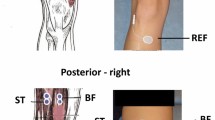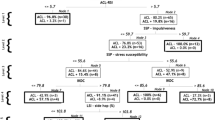Abstract
Purpose
This 3-year prospective study assessed risk factors for noncontact anterior cruciate ligament (ACL) injuries in female Japanese high school basketball players. Players suffering noncontact ACL injuries were assumed to demonstrate poorer hip abductor, knee flexor, and knee extensor muscle strength, as well as static balance, than those without injuries.
Methods
One hundred and ninety-five new female high school basketball players underwent baseline examinations for various parameters during their first year of high school. After the baseline data were collected, all ACL injuries occurring over the subsequent 3 years were recorded. The assessment parameters between the noncontact ACL injury group and the control group were compared.
Results
Of the 195 players, 24 were excluded due to pre-existing injuries present during the initial examination, quitting the basketball club during the follow-up period, or missing data. The remaining 171 players were observed for 3 years; unilateral noncontact ACL injuries were occurred in 12 players. Significantly lower general joint laxity and greater hip abductor strength were observed in the ACL injury group than in the control group. Body mass index (BMI) and hip abductor strength were significantly greater in the ACL injury group than in the control group, based on logistic regression analysis.
Conclusions
Greater BMI and hip abductor muscle strength were independent risk factors for noncontact ACL injuries in female Japanese high school basketball players. Although performing complete screens may be difficult, attention should be given to ACL injuries, particularly in highly competitive players with strong muscles.
Level of evidence
III.

Similar content being viewed by others
Abbreviations
- ACL:
-
Anterior cruciate ligament
- BMI:
-
Body mass index
- CI:
-
Confidence interval
- GJL:
-
General joint laxity
- H/Q:
-
Hamstring/quadriceps
References
Ajuied A, Wong F, Smith C, Norris M, Earnshaw P, Back D, Davies A (2014) Anterior cruciate ligament injury and radiologic progression of knee osteoarthritis: a systematic review and meta-analysis. Am J Sports Med 42:2242–2252
Beighton P, Solomon L, Soskolne CL (1973) Articular mobility in an African population. Ann Rheum Dis 32:413–418
Bisciotti GN, Chamari K, Cena E, Carimati G, Volpi P (2016) ACL injury in football: a literature overview of the prevention program. Muscles Ligaments Tendons J 6:473–479
Demura S, Yamaji S, Noda M, Kitabayashi T, Nagasawa Y (2001) Examination of parameters evaluating the center of foot pressure in static standing posture from viewpoints of trial-to-trial reliability and interrelation4ships among parameters. Equilib Res 60:44–55
Dunn KL, Lam KC, Valovich McLeod TC (2016) Early operative versus delayed or nonoperative treatment of anterior cruciate ligament injuries in pediatric patients. J Athl Train 51:425–427
Evans KN, Kilcoyne KG, Dickens JF, Rue JP, Giuliani J, Gwinn D, Wilckens JH (2012) Predisposing risk factors for non-contact ACL injuries in military subjects. Knee Surg Sports Traumatol Arthrosc 20:1554–1559
Fernandes TL, Felix EC, Bessa F, Luna NM, Sugimoto D, Greve JM, Hernandez AJ (2016) Evaluation of static and dynamic balance in athletes with anterior cruciate ligament injury—a controlled study. Clinics (Sao Paulo) 71:425–429
Frank B, Bell DR, Norcross MF, Blackburn JT, Goerger BM, Padua DA (2013) Trunk and hip biomechanics influence anterior cruciate loading mechanisms in physically active participants. Am J Sports Med 41:2676–2683
Gornitzky AL, Lott A, Yellin JL, Fabricant PD, Lawrence JT, Ganley TJ (2016) Sport-specific yearly risk and incidence of anterior cruciate ligament tears in high school athletes: a systematic review and meta-analysis. Am J Sports Med 44:2716–2723
Hashemi J, Breighner R, Chandrashekar N, Hardy DM, Chaudhari AM, Shultz SJ, Slauterbeck JR, Beynnon BD (2011) Hip extension, knee flexion paradox: a new mechanism for non-contact ACL injury. J Biomech 44:577–585
Hewett TE, Ford KR, Hoogenboom BJ, Myer GD (2010) Understanding and preventing acl injuries: current biomechanical and epidemiologic considerations—update 2010. N Am J Sports Phys Ther 5:234–251
Hewett TE, Myer GD, Ford KR (2006) Anterior cruciate ligament injuries in female athletes part 1, mechanisms and risk factors. Am J Sports Med 34:299–311
Hewett TE, Myer GD, Ford KR, Heidt RS Jr, Colosimo AJ, McLean SG, van den Bogert AJ, Paterno MV, Succop P (2005) Biomechanical measures of neuromuscular control and valgus loading of the knee predict anterior cruciate ligament injury risk in female athletes: a prospective study. Am J Sports Med 33:492–501
Hutchinson AB, Yao P, Hutchinson MR (2016) Single-leg balance and core motor control in children: when does the risk for ACL injury occurs? BMJ Open Sport Exerc Med 2:e000135
Khayambashi K, Ghoddosi N, Straub RK, Powers CM (2016) Hip muscle strength predicts noncontact anterior cruciate ligament injury in male and female athletes: a prospective study. Am J Sports Med 44:355–361
Kitabayashi T, Demura S, Noda M (2003) Examination of the factor structure of center of foot pressure movement and cross-validity. J Physiol Anthropol Appl Human Sci 22:265–272
Kluczynski MA, Marzo JM, Bisson LJ (2013) Factors associated with meniscal tears and chondral lesions in patients undergoing anterior cruciate ligament reconstruction: a prospective study. Am J Sports Med 41:2759–2765
Kosaka M, Nakase J, Numata H, Oshima T, Takata Y, Moriyama S, Oda T, Shima Y, Kitaoka K, Tsuchiya H (2016) Psychological traits regarding competitiveness are related to the incidence of anterior cruciate ligament injury in high school female athletes. Knee 23:681–685
Lloyd DG, Buchanan TS, Besier TF (2005) Neuromuscular biomechanical modeling to understand knee ligament loading. Med Sci Sports Exerc 37:1939–1947
Markolf KL, Jackson SR, Foster B, McAllister DR (2014) ACL forces and knee kinematics produced by axial tibial compression during a passive flexion-extension cycle. J Orthop Res 32:89–95
Martinez JC, Mazerolle SM, Denegar CR, Joseph MF, Pagnotta KD, Trojian TH, DiStefano LJ (2017) Female adolescent athletes’ attitudes and perspectives on injury prevention programs. J Sci Med Sports 20:146–151
Myer GD, Ford KR, Barber Foss KD, Liu C, Nick TG, Hewett TE (2009) The relationship of hamstrings and quadriceps strength to anterior cruciate ligament injury in female athletes. Clin J Sport Med 19:3–8
Nakase J, Inaki A, Mochizuki T, Toratani T, Kosaka M, Ohashi Y, Taki J, Yahata T, Kinuya S, Tsuchiya H (2013) Whole body muscle activity during the FIFA 11 + program evaluated by positron emission tomography. PLoS One 8:e73898
Nguyen AD, Shultz SJ, Schmitz RJ, Luecht RM, Perrin DH (2011) A preliminary multifactorial approach describing the relationships among lower extremity alignment, hip muscle activation, and lower extremity joint excursion. J Athl Train 46:246–256
Nwachukwu BU, Anthony SG, Lin KM, Wang T, Altchek DW, Allen AA (2017) Return to play and performance after anterior cruciate ligament reconstruction in the National Basketball Association: surgeon case series and literature review. Phys Sportsmed 45:303–308
Oiestad BE, Holm I, Aune AK, Gunderson R, Myklebust G, Engebretsen L, Fosdahl MA, Risberg MA (2010) Knee function and prevalence of knee osteoarthritis after anterior cruciate ligament reconstruction: a prospective study with 10 to 15 years of follow-up. Am J Sports Med 38:2201–2210
Paterno MV, Schmitt LC, Ford KR, Rauh MJ, Myer GD, Huang B, Hewett TE (2010) Biomechanical measures during landing and postural stability predict second anterior cruciate ligament injury after anterior cruciate ligament reconstruction and return to sport. Am J Sports Med 38:1968–1978
Prodromos CC, Han Y, Rogowski J, Joyce B, Shi K (2007) A meta-analysis of the incidence of anterior cruciate ligament tears as a function of gender, sport, and a knee injury-reduction regimen. Arthroscopy 23:1320–1325
Risberg MA, Oiestad BE, Gunderson R, Aune AK, Engebretsen L, Culvenor A, Holm I (2016) Changes in knee osteoarthritis, symptoms, and function after anterior cruciate ligament reconstruction: a 20-year prospective follow-up study. Am J Sports Med 44:1215–1224
Ruwe PA, Gage JR, Ozonoff MB, DeLuca PA (1992) Clinical determination of femoral anteversion. A comparison with established techniques. J Bone Jt Surg Am 74:820–830
Shultz SJ, Carcia CR, Gansneder BM, Perrin DH (2006) The independent and interactive effects of navicular drop and quadriceps angle on neuromuscular responses to a weight-bearing perturbation. J Athl Train 41:251–259
Shultz SJ, Schmitz RJ, Nguyen AD, Chaudhari AM, Padua DA, McLean SG, Sigward SM (2010) ACL research retreat V: an update on ACL injury risk and prevention, March 25–27, 2010, Greensboro, NC. J Athl Train 45:499–508
Smith HC, Vacek P, Johnson RJ, Slauterbeck JR, Hashemi J, Shultz S, Beynnon BD (2012) Risk factors for anterior cruciate ligament injury: a review of the literature—part 1: neuromuscular and anatomic risk. Sports Health 4:69–78
Soligard T, Grindem H, Bahr R, Andersen TE (2010) Are skilled players at greater risk of injury in female youth football? Br J Sports Med 44:1118–1123
Steffen K, Nilstad A, Kristianslund EK, Myklebust G, Bahr R, Krosshaug T (2016) Association between lower extremity muscle strength and noncontact ACL injuries. Med Sci Sports Exerc 48:2082–2089
Steffen K, Nilstad A, Krosshaug T, Pasanen K, Killingmo A, Bahr R (2017) No association between static and dynamic postural control and ACL injury risk among female elite handball and football players: a prospective study of 838 players. Br J Sports Med 51:253–259
Taylor JB, Waxman JP, Richter SJ, Shultz SJ (2015) Evaluation of the effectiveness of anterior cruciate ligament injury prevention programme training components: a systematic review and meta-analysis. Br J Sports Med 49:79–87
Thorborg K, Bandholm T, Hölmich P (2013) Hip- and knee-strength assessments using a hand-held dynamometer with external belt-fixation are inter-tester reliable. Knee Surg Sports Traumatol Arthrosc 21:550–555
Uhorchak JM, Scoville CR, Williams GN, Arciero RA, St Pierre P, Taylor DC (2003) Risk factors associated with noncontact injury of the anterior cruciate ligament. a prospective four-year evaluation of 859 West Point cadets. Am J Sports Med 31:831–842
Vacek PM, Slauterbeck JR, Tourville TW, Sturnick DR, Holterman LA, Smith HC, Shultz SJ, Johnson RJ, Tourville KJ, Beynnon BD (2016) Multivariate analysis of the risk factors for first-time noncontact ACL injury in high school and college athletes: a prospective cohort study with a nested, matched case-control analysis. Am J Sports Med 44:1492–1501
Waldén M, Hägglund M, Werner J, Ekstrand J (2011) The epidemiology of anterior cruciate ligament injury in football (soccer): a review of the literature from a gender-related perspective. Knee Surg Sports Traumatol Arthrosc 19:3–10
Willson JD, Ireland ML, Davis I (2006) Core strength and lower extremity alignment during single leg squats. Med Sci Sports Exerc 38:945–952
Zazulak BT, Hewett TE, Reeves NP, Goldberg B, Cholewicki J (2007) Deficits in neuromuscular control of the trunk predict knee injury risk: a prospective biomechanical-epidemiologic study. Am J Sports Med 35:1123–1130
Funding
No funding has been received for this study.
Author information
Authors and Affiliations
Corresponding author
Ethics declarations
Conflict of interest
The authors have no conflicts of interest.
Ethical approval
This study was approved by the Ethical Committee of the Graduate School of Medical Sciences, Kanazawa University (approval # 1050).
Informed consent
All participants and their parents coaches were given a thorough explanation of the study design and voluntarily provided written informed consent.
Rights and permissions
About this article
Cite this article
Shimozaki, K., Nakase, J., Takata, Y. et al. Greater body mass index and hip abduction muscle strength predict noncontact anterior cruciate ligament injury in female Japanese high school basketball players. Knee Surg Sports Traumatol Arthrosc 26, 3004–3011 (2018). https://doi.org/10.1007/s00167-018-4888-4
Received:
Accepted:
Published:
Issue Date:
DOI: https://doi.org/10.1007/s00167-018-4888-4




